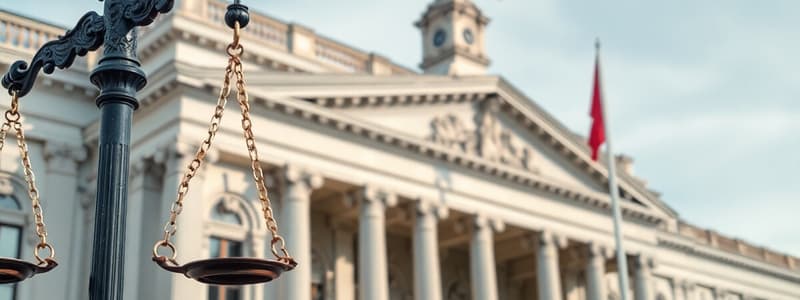Podcast
Questions and Answers
Who is responsible for assigning cases to judges in Canadian courts?
Who is responsible for assigning cases to judges in Canadian courts?
- The Prime Minister
- The Attorney General
- The Chief Justice (correct)
- The Governor General
What is the primary role of the Supreme Court of Canada?
What is the primary role of the Supreme Court of Canada?
- To oversee municipal laws
- To hear appeals and decide constitutional questions (correct)
- To represent the Canadian provinces in international matters
- To create new laws for the country
Which document serves as the primary legal protection of rights in Canada?
Which document serves as the primary legal protection of rights in Canada?
- The British North America Act
- The Canadian Charter of Rights and Freedoms (correct)
- The Canadian Bill of Rights
- The Canadian Constitution
How many judges are on the Supreme Court of Canada?
How many judges are on the Supreme Court of Canada?
What rights does the Canadian Charter of Rights and Freedoms apply to?
What rights does the Canadian Charter of Rights and Freedoms apply to?
What was the main reason for the enactment of the Canadian Charter of Rights and Freedoms?
What was the main reason for the enactment of the Canadian Charter of Rights and Freedoms?
How many applications for leave to appeal does the Supreme Court consider annually?
How many applications for leave to appeal does the Supreme Court consider annually?
Which of the following rights belongs exclusively to citizens of Canada under the Charter?
Which of the following rights belongs exclusively to citizens of Canada under the Charter?
What is the primary role of the courts in Canada?
What is the primary role of the courts in Canada?
Which of the following correctly represents the hierarchy of courts in Canada?
Which of the following correctly represents the hierarchy of courts in Canada?
What is the significance of judicial independence in the Canadian judicial system?
What is the significance of judicial independence in the Canadian judicial system?
Which body has the authority to remove a judge in Canada?
Which body has the authority to remove a judge in Canada?
Which of the following statements about the levels of courts in Canada is false?
Which of the following statements about the levels of courts in Canada is false?
What is one of the components of judicial independence?
What is one of the components of judicial independence?
Which court in Canada has jurisdiction over more serious crimes?
Which court in Canada has jurisdiction over more serious crimes?
What type of cases does the Federal Court in Canada handle?
What type of cases does the Federal Court in Canada handle?
What is a primary purpose of Section 1 of the Charter of Rights and Freedoms?
What is a primary purpose of Section 1 of the Charter of Rights and Freedoms?
What is the Oakes test used for?
What is the Oakes test used for?
Which of the following is NOT a component of the Oakes test?
Which of the following is NOT a component of the Oakes test?
In the case of the Alberta law regarding termination based on sexual orientation, what was the main reason the Supreme Court found the law unconstitutional?
In the case of the Alberta law regarding termination based on sexual orientation, what was the main reason the Supreme Court found the law unconstitutional?
What was the primary finding of the Supreme Court regarding the Quebec law in 1988 mandating French-only signs?
What was the primary finding of the Supreme Court regarding the Quebec law in 1988 mandating French-only signs?
Which of the following is NOT considered a fundamental freedom under Section 2 of the Charter?
Which of the following is NOT considered a fundamental freedom under Section 2 of the Charter?
What must be demonstrated for an infringement to be considered justifiable under Section 1?
What must be demonstrated for an infringement to be considered justifiable under Section 1?
Which of the following best describes the concept of 'minimal impairment' in the context of the Oakes test?
Which of the following best describes the concept of 'minimal impairment' in the context of the Oakes test?
What happens if parties do not agree to mediation in a dispute?
What happens if parties do not agree to mediation in a dispute?
What is one responsibility of courts when reviewing government decision-makers' actions?
What is one responsibility of courts when reviewing government decision-makers' actions?
How can courts act as a tool for social change?
How can courts act as a tool for social change?
What was a significant social change influenced by court decisions?
What was a significant social change influenced by court decisions?
Flashcards are hidden until you start studying
Study Notes
The Courts
- The court system is designed to interpret, apply and resolve disputes of the law.
- Designed to be independent of government.
- Four levels of courts acting as appeals mechanisms.
- Canadian courts enforce the Constitution's Canadian Charter of Rights and Freedoms which provides four fundamental freedoms and six basic rights.
Judicial Independence
- Guarantees judges can act freely and free of influence, based only on fact and law.
- Judges are appointed by a non-partisan screening committee.
- Three components: security of tenure, financial security and administrative independence.
Canada's Court System
- Each province and territory has its own courts.
- The Supreme Court of Canada presides over the entire system.
- Each court in Canada has its own jurisdiction:
- Provincial lower courts.
- Provincial superior courts, responsible for more serious crimes.
- Federal Court, responsible for matters assigned to it by federal legislation.
- Provincial/Federal Courts of Appeal.
- The Supreme Court of Canada.
The Supreme Court of Canada
- The Supreme Court of Canada serves as the final court of appeal in Canada.
- Nine judges from across Canada represent the four major regions of the country.
- Two main functions:
- Hear appeals from decisions of appeal courts.
- Decide important constitutional questions and controversial areas of law.
- The government can ask the Supreme Court for its opinion on important legal questions.
Canadian Charter of Rights and Freedoms
- Provides four fundamental freedoms and six basic rights to everyone in Canada.
- Only applies to government actions.
- Enacted in 1982.
- Section 1- limitations clause- allows governments to justify certain infringements of the Charter rights.
- Section 2- lists “fundamental freedoms”: freedom of conscience, religion, thought, belief, expression, the press, peaceful assembly, and association.
Oakes Test
- Test to determine if a legislative infringement is "demonstrably justifiable in a free and democratic society”.
- Five parts:
- Pressing and substantial objective.
- Proportional means.
- Means are rationally connected to the objective.
- Minimal impairment of rights.
- Proportionality between the infringement and the objective.
Human Rights Tribunal of Ontario
- Offers parties the opportunity to settle the dispute through mediation.
- If mediation fails, the HRTO holds a hearing.
Administrative Law
- Courts review decisions made by government decision-makers, boards, tribunals or agencies.
- They ensure:
- Decision-makers act within the limits of their authority.
- Discretion is observed through procedurally fair means.
Courts as a Method for Change
- Courts and tribunals are used as a tool for change.
- Individuals, advocacy groups, government, and others can initiate litigation.
- The courts allow people, organizations or governments to intervene in a court decision and file "amicus briefs".
- Many examples of social change and resistance to government changes result from court decisions.
- Change can happen over time and may take multiple “tries” before things change.
Case Study: HIV Non-disclosure
- The Supreme Court ruled in 1998 that failing to disclose HIV status before engaging in sexual relations that pose a “significant risk” of transmitting the virus was a criminal act.
- This was supported by common law and Charter section 7.
- Many HIV-positive individuals were charged with aggravated sexual assault.
- Advocates argued the law placed an unfair burden on HIV-positive Canadians.
- In 2012, the Supreme Court clarified the disclosure requirement:
- A “realistic possibility” of transmission must exist to require disclosure.
- Disclosure isn't required when a condom is used and the HIV-positive person has a low viral load.
- In 2018, the federal government issued a directive to federal prosecutors that cases shouldn’t proceed where there is a low viral load, where a condom was used, or partners engaged only in oral sex.
Case Study: Assisted Dying
- The Supreme Court reviewed a Superior Court decision upholding the federal Criminal Code provision that criminalized assisting a person in committing suicide.
- The Supreme Court ruled in favor of assisted dying.
Case Study: Same-sex Marriage
- Important case for social change.
- Significant Supreme Court ruling recognized the right to same-sex marriage in Canada.
Studying That Suits You
Use AI to generate personalized quizzes and flashcards to suit your learning preferences.




